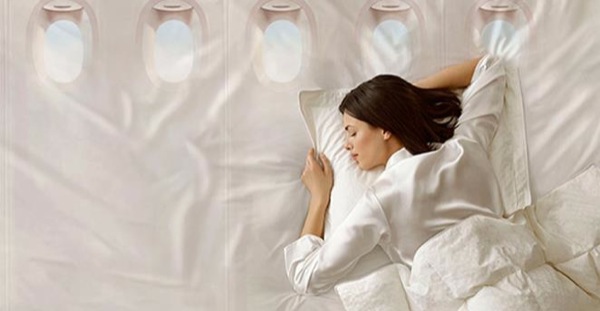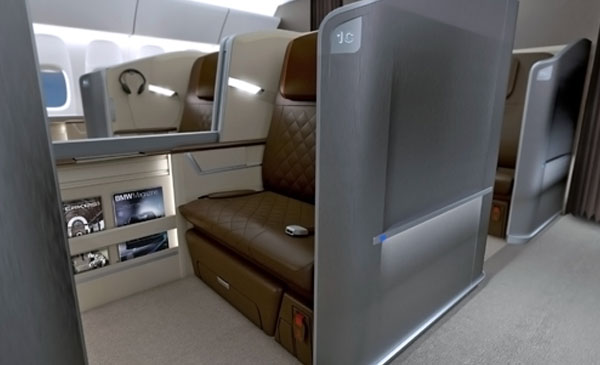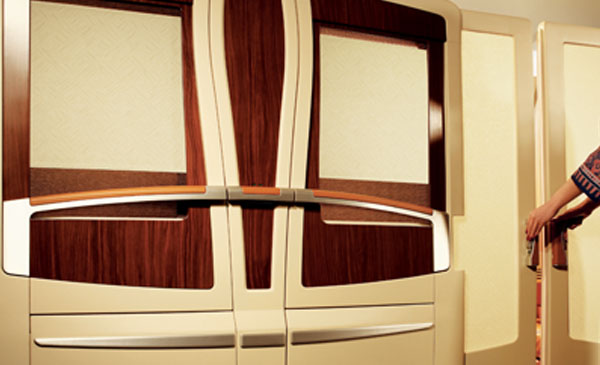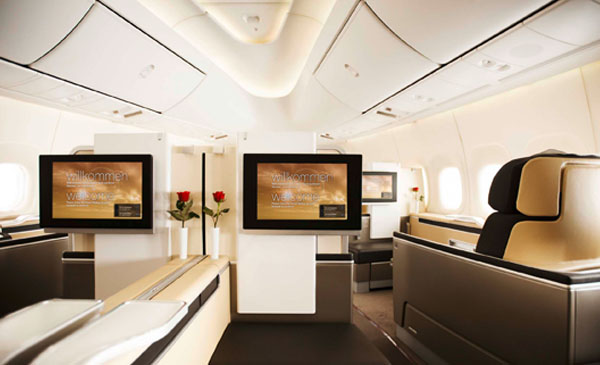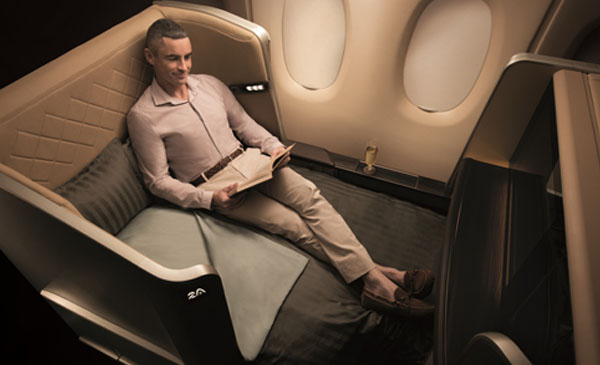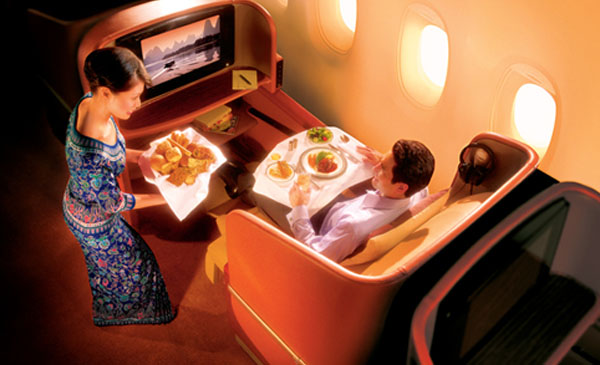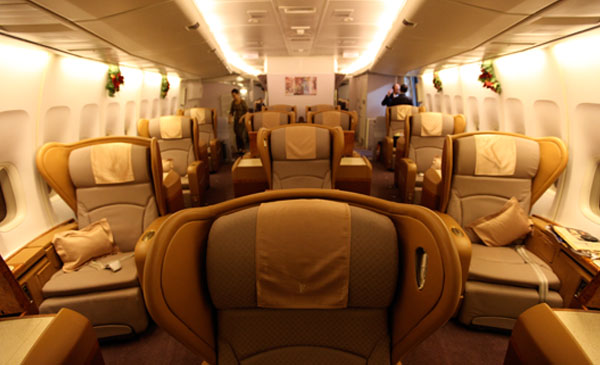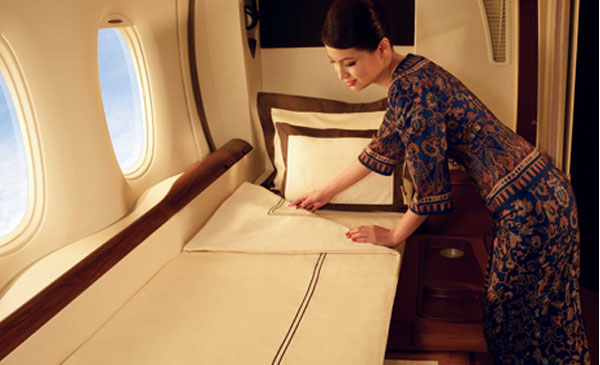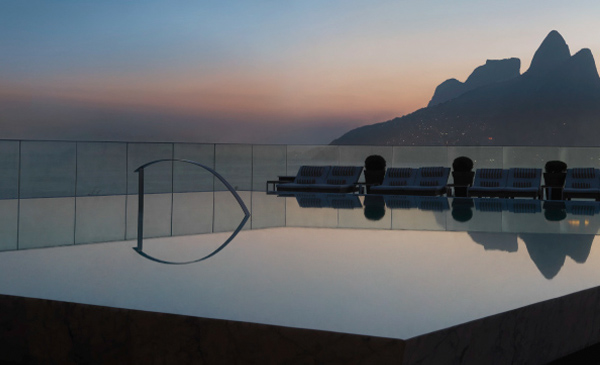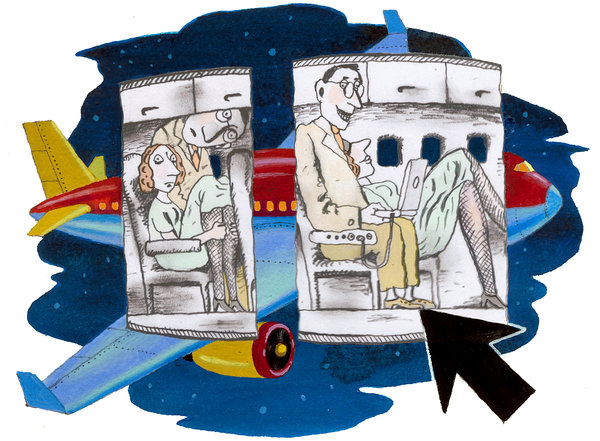New first-class seating units can cost more than half a million dollars each.

Seven years ago, I flew business class on Qantas from Australia to California, a thirteen-hour trip. I hadn’t had much experience outside economy, but I didn’t want to look like a front-of-the-plane rookie, so I stowed my “amenity kit” without ripping it open, declined the first cocktail a flight attendant offered me, and tried to appear engrossed in a book while the passenger nearest me bounced around like a four-year-old at a birthday party. I didn’t begin to play with my own seat until after dinner, when I lowered it into its fully extended position, and stretched out—not to sleep, which is something I hardly ever manage on airplanes, but to see how the thing worked. The concave back of the seat shell formed a domed enclosure over my head, like a demi-cocoon. Suddenly, I heard people speaking in loud voices and banging things around. I sat up, indignant—and realized that the noise was the sound of breakfast being served. I’d slept for eight hours straight, something I never do even at home. In a little while, we began our descent into Los Angeles.

In the early nineties, the best seats on airplanes were still just seats, even if they reclined almost all the way back. Then, in 1995, in first class on some long flights, British Airways introduced seats that turned into fully flat beds, and within a relatively short period airborne sleeping became a potent competitive weapon. The carriers that fly the wealthiest passengers on the longest routes have been especially aggressive about adding comforts, in both first and business (while also often shrinking the seats in economy and squeezing them closer together). A first-class passenger on the upper deck of some Lufthansa 747s gets to hop back and forth between a reclining seat and an adjacent full-length bed. On some of Singapore Airlines’ A380s, a couple travelling in first can combine two “suites” to create an enclosed private room with a double bed and sliding doors. On some flights on Emirates, first-class passengers who make a mess of the treats in their personal minibar can tidy up with a shower before they land.
The modern aircraft-seating industry is highly specialized. The number of manufacturers is small, in part because creating new seats is so complex that moving from conception to installation takes years and entails large financial risks. It also poses unique design challenges, since a premium-class seat has to create an impression of opulence in what is actually a noisy and potentially nausea-inducing metal tube filled with strangers. If you checked into a luxury hotel and were taken to a room the size of a first-class airplane cabin, and told that you’d be sharing it with eleven people you didn’t know, all of whom would be sleeping within a few feet of your own skinny bed, you wouldn’t be thrilled, especially if you were paying twenty thousand dollars for the experience. Yet it’s not unheard of for people who travel long distances in really good seats to remember the flight as one of the best parts of their trip. Making them feel that way requires a particular kind of design and engineering skill, along with what amounts, almost, to psychological sleight of hand.

In March, TheDesignAir, an air-travel Web site, published its second annual ranking of the best international business classes. The winning airline was Singapore, and the runner-up was Cathay Pacific, which is based in Hong Kong. One interesting fact about Singapore and Cathay is that they held the same positions on last year’s list, though in the other order. Another is that the business-class seats on both were created by the same design firm: James Park Associates, whose main office occupies three rooms in a building on Worship Street, in Shoreditch, in East London. Just inside the largest room is a worktable surrounded on three sides by IKEA bookcases filled with fabric swatches, carpet samples, and plastic bags containing pajamas, robes, and other “soft goods” that J.P.A. created for first-class cabins on Air China. In the main part of the room, two dozen designers work shoulder-to-shoulder at computers on two long tables.
James Park, the firm’s founder and principal, is sixty-seven years old, and when he’s wearing his glasses he looks a little like the poet Philip Larkin. He earned a degree in architecture in 1974 at London’s Architectural Association, whose other alumni include Zaha Hadid, Rem Koolhaas, and Richard Rogers. His first job after graduation was with the Louis de Soissons Partnership, a distinguished architectural practice. When that firm moved out of London, he left and took what he assumed would be a stopgap job: helping to restore and design vintage railway carriages for the Venice Simplon-Orient-Express, a luxury private-train service.
“The train project became much more involving and much more enjoyable than I’d thought it would,” Park told me recently, as we sat at a big table in the firm’s conference room. “There was a lot of marquetry and very high-quality finishes in the interiors.” There was also the challenge of fitting things together in a way that would allow the wooden panels to move without splitting or cracking. “That’s a tricky problem, because a train car is moving all the time, and it isn’t a completely rigid object,” he said. “It also contracts and expands—say, as it goes up into the mountains and then comes down to Venice in the summer.”
One of the old train cars was so badly corroded that it couldn’t be salvaged. Park cut it in half, and studied, in cross-section, the way the interior had been assembled—a technique that he and his colleagues adopted, and called “loose-fit technology.” To explain, he took my pen and a piece of scrap paper, and sketched the profile of a train car sliced vertically, across its width: ceiling, frieze, raised panel, heater grille, skirting, floor—all made of wood. The parts fit together in a way that allowed them to move on their anchors, he said, and each panel was secured by a horizontal piece, which was screwed in place. “If you simply removed that one piece, you could dismantle the whole thing, because it was all interlocking,” he said. “All you needed was a screwdriver.”

That train restoration led to others. Then, in the early nineteen-nineties, Singapore Airlines invited J.P.A. to compete for the job of reconceiving the first-class cabins on its Boeing 747s. “They were interested in us because of the trains, because we’d shown we were good at dealing with small spaces,” Park said. He quickly decided that aviation seating had changed little in decades, and that even in first class the ambience was coldly utilitarian. The seats were large, and they reclined, but they looked more like dentist’s chairs than like luxury furniture. “We decided to try to do something about the way the elements were put together and presented, to make them more comfortable, and to provide more of a club atmosphere,” he said.
The interiors that Park created for the Orient-Express trains resemble rolling versions of Downton Abbey, but achieving that effect while satisfying late-twentieth-century safety regulations required lots of modern technology. All of Park’s “loose-fit” woodwork had to be anchored securely enough to remain intact after a train wreck, and it had to be impregnated with a flame-retardant chemical and finished not with ordinary varnishes or paints but with what are known as “intumescent” coatings, which foam up when they’re exposed to high heat, forming an insulating layer that prevents the underlying wood from igniting.

Airplane interiors are even more tightly regulated. Nearly every element undergoes a safety-enhancing process called “delethalization”: seats have to withstand an impact equal to sixteen times the force of gravity, and to remain in place when they do, so that they don’t block exit routes or crush anyone, and they can’t burst into flames or release toxic gases when they get hot. Doing something as simple as slightly increasing the thickness of the padding in a seat cushion can necessitate a new round of testing and certification, because a more resilient seat could make a passenger bounce farther after an impact, increasing the risk of injury caused by turbulence or a hard landing. Delethalizing some premium-class seats—in which a passenger’s head and torso have a lot of room to accelerate before being stopped by something solid—requires the addition of a feature that many passengers don’t even realize is there: an air bag concealed in the seat belt.

In economy, the tight spacing of the seats makes air bags mostly unnecessary. But seat-back video screens and the hard frames that surround them pose a safety challenge, partly because of the potential for injuries caused by head strikes, and partly because the computers and the electrical systems that serve them have to be both fireproof and fully isolated from the plane’s—so that crossed wires in somebody’s seat don’t allow a ten-year-old playing a video game to suddenly take control of the cockpit. Largely as a result, in-flight entertainment systems are almost unbelievably expensive. The rule of thumb, I was told, is “a thousand dollars an inch”—meaning that the small screen in the back of each economy seat can cost an airline ten thousand dollars, plus a few thousand for its handheld controller.
At the same time, nearly every surface on an airline seat has to be easily replaceable during the brief interval between landing and takeoff, so that if a passenger spills a glass of red wine the seat won’t have to be kept vacant for the following flight: a lost fare. No design change is made casually, because even small ones can affect operating costs. Gulf Air, which is based in Bahrain, reduced its annual fuel bill by a hundred and twenty thousand dollars a few years ago by using slightly thinner leather in the upholstery of its first-class seats—a change that involved just sixteen seats on fifteen planes.
Despite such challenges, J.P.A. created a first-class cabin for Singapore that was seductively different from anyone else’s. The seats, which could be transformed into fully flat beds, looked less like conventional airplane seats than like oversized wing chairs, each with its own ottoman, dining table, and wood-framed video monitor. (The “wood” was actually a delethalized photographic imitation.) The new seats first flew in 1998. They won many awards and remained in service in their original form for almost a decade. Their successors fly today.
The Singapore job enhanced J.P.A.’s reputation, and not just in aviation. The firm created a first-class lounge for Singapore Airlines at Changi Airport, and soon afterward it won contracts for several hotel renovations, including, in 2009, a hundred-million-dollar redesign of the guest rooms in the Pierre, in New York. (Most of J.P.A.’s hotel work is handled by a second office, in Singapore.) As a result, the firm’s portfolio grew to include luxury environments on a variety of scales, and Park’s conception of what J.P.A. does inside aircraft extended from the plane to the airport and beyond. “There are certain little events you experience as you progress through this promenade up to the plane,” he told me. “They should climax in your vision of the seat.”
One afternoon, I drove to Heathrow with John Tighe, a design director at J.P.A., to see a new long-haul business-class seat, called Next Generation, which the firm created for Singapore, and which first flew last year. Tighe is thirty-two years old, and before coming to J.P.A. he worked for both a seat manufacturer and an airline; he said that he has become “bilingual in measurement.” He slips effortlessly between metric and English units, both of which are used in the industry, and isn’t thrown by the occasional oddball unit, such as a mysterious Taiwanese measure that, he said, turned out to be slightly more than an inch.
Boarding an airplane with no boarding pass takes some doing. We presented our passports at an airport office, and were escorted through security and onto the plane by an airline employee. Departure was an hour and a half away, and flight attendants were bustling like stagehands on opening night. Singapore’s attendants were made famous by the airline’s early-seventies motto, “Singapore Girl, you’re a great way to fly,” and they still wear batik sarong kebayas designed in 1968 by Pierre Balmain. To stay out of their way, I sat in one of the new seats, a capacious but invitingly snug enclosure. Nearly every hard surface was a curve, and the colors were soothing: tan, mauve, plum, taupe, coppery-pinkish, brown. The plane had two business-class sections: a small one, with just eight seats, directly behind first class, and a larger one behind that, with thirty-four seats. To keep the larger section from seeming enormous (and therefore less exclusive), J.P.A. had used different upholstery tones in alternate seats, checkerboard style—a pattern that causes the brain to register less than the entire expanse. “In a way, it’s a trick of the eye,” Tighe said. “It cuts down on the perception of the repetition of objects.”
Tighe pushed a button on a control panel near my arm, and hidden downlights subtly accentuated the detailing in the console on my right. A button on the inner surface of the aisle-side armrest, he showed me, was positioned so that a Singapore Girl could switch off my video screen once I’d fallen asleep. He extended the tabletop, and said that a Singapore Girl could do that from the aisle, too, without reaching across my lap, and then he raised it into the proper position for breakfast in bed. He clicked open a door to the right of the video console, revealing a lighted makeup mirror—useful upon arrival. “A good seat doesn’t show you everything it’s got in the first ten minutes,” he said. “It surprises you during the flight, and lets you discover things you weren’t expecting.” Such features can pay off in unexpected ways: passengers who like their seats tend to give higher ratings to everything on their flight, including movie selections that haven’t changed.

To the left of the video screen was a retractable coat hook—a surprisingly humble accessory, given that long-haul first-class seats nowadays often have a shallow personal “closet,” in which passengers can hang things like jackets and sweaters. But Tighe explained that the simplicity was intentional. Singapore had stipulated that nothing J.P.A. did should undermine the airline’s emphasis on personal service, and the hook, he said, creates an opportunity for passenger interaction. “You might hang your jacket on it when you arrive at your seat, but by the time you’ve sat down a flight attendant will have taken it away.” Similarly, J.P.A. designed the seat so that its transformation into a bed is mainly a manual operation, rather than, as is common, something a passenger can do by pushing buttons. “Usually, a flight attendant will make your bed up for you, maybe while you’re getting ready to go to sleep,” he said. The upper part of the bed is created by pulling down the seat back, revealing a flat, fabric-covered mattress section attached to the other side. (Leather is nice for sitting and is easy to clean quickly, but it can be hot and slippery for sleeping.) A cantilevered panel fills the gap between that surface and the stationary footrest, and then a Singapore Girl adds bedding and a pillow. Manual operation has the additional benefit of reducing the seat’s weight, by shrinking the machinery inside it.
Next Generation, as the name suggests, evolved from an earlier seat that J.P.A. designed for Singapore. In both, the passenger sits facing forward but sleeps on the diagonal, an innovation that makes it possible to create what looks like a first-class experience in a significantly smaller space. In bed mode, each seating unit borrows some empty volume from the underside of the shell of the seat in front of it. Designing seats is like solving a three-dimensional puzzle, in which all the pieces have to fit together and even tiny spaces can be significant. During one project, on which J.P.A. worked essentially around the clock, by using employees in both of its offices, the designers in Singapore sent the designers in London an exultant overnight message saying that they thought they’d found another half inch.
Beds on aircraft aren’t a recent invention. Some of Pan Am’s early planes had Pullman-style berths, and on one of those planes, in 1937, a crew member woke a man and asked to look out his window, so that he could complete his celestial navigation chart, because he hadn’t been able to see the North Star clearly from the cockpit. The awakened passenger recalled later that the actress Anna May Wong, who had starred in the film “Shanghai Express” five years earlier, was in the berth across the aisle, and that he knew she was asleep, on the other side of her curtain, because he could hear “a kind of soft snore.” As air travel extended down the income scale, though, and as airplanes got faster, bedlike sleeping surfaces became less common, then disappeared, until British Airways reintroduced them, in the nineties.
Early flights were classless in the sense that only the wealthy could afford them. (In 1938, a ticket on Imperial’s flight from London to Durban, which took six days, cost a hundred and twenty-five pounds, hotels and meals included—a little less than a quarter of the cost of an average house.) On early mixed-class planes, the first-class seats were sometimes back near the tail, farther from the noise of the engines and, perhaps, from the chauffeur-like men handling the controls. In 1977, British Airways introduced a third division, a mid-plane Executive Cabin, which it described as having “a quiet, exclusive atmosphere free from the distraction of movies and young babies.” The seats and their spacing were the same as those in economy, but the section was intended for passengers paying nondiscounted fares—typically, business travellers.
The first true business class arose soon afterward, and versions of it have evolved, since then, in response to the fluctuations of national economies, the increased competition that followed airline deregulation, and other factors. One key to its success is that many of the tickets are purchased with the world’s oldest virtual currency: Other People’s Money. For self-paying passengers who upgrade with frequent-flier miles, the cost is supported by things like the fees that retailers pay to credit-card companies, which buy miles in bulk from airlines and distribute them to cardholders as rewards; for corporate executives and their lawyers, bankers, and consultants, the expense is partly borne by shareholders, as is also the case with corporate jets. (Private jets divide the wealthy into two classes: there are the rich, who fly first class without thinking about it, and then there are the jet-rich, who have never seen the inside of Concourse B.)
Not long after beds returned to first class, they began to appear in business class, too. Today, the variation in detail, size, spacing, comfort, and ticket price in all classes is so great that traditional cabin designations aren’t very meaningful. Ben Orson, the managing director of J.P.A.’s London office, told me that it’s probably more accurate to think of seating types as tightly spaced points on a continuum—from the thrombosis-inducing perches on regional jets to the bedroom-like micro-palaces on Emirates and Etihad. Between those extremes is a Cambrian explosion of features and variants, including an emerging intermediate class with names like Economy Comfort, Economy Plus, and Main Cabin Extra. Air New Zealand has been especially innovative, and in recent years has introduced two distinctive seat types: the Skycouch, which is formed by turning three adjacent economy seats into a broad mini-bed, and the Spaceseat, which the company classifies as “premium economy” but on some airlines might pass for business class.
Competing for travellers in this way is economically risky. Some first-class cabins on Kingfisher Airlines, based in India, had a bar, a bartender, and a spacious lounging area, as well as a chef who prepared delicacies to order. But Kingfisher stopped flying in 2012, after just seven years in operation, in part because it had allocated too much cabin space to functions that delighted passengers but produced no revenue.
Yet moderation is risky, too. Premium cabins contribute disproportionately to an airline’s economic performance—both directly, through higher ticket prices, and indirectly, by solidifying relationships with big-budget customers who fly all the time. Business class is especially valuable; first class can be problematic, because first-class ticket holders require extra pampering and won’t tolerate overbooking. Web sites like SeatGuru enable picky fliers to compare seats on many routes, and keeping such fliers loyal is expensive: new first-class seating units can cost more than half a million dollars each. Jami Counter, a senior director at TripAdvisor, which owns SeatGuru, told me, “The true international first-class cabin actually keeps shrinking, because the international business-class cabin has become such a great product, to the point where you’re differentiating more on things like food and service.”
Because costs are high, passenger density is extremely important, especially outside first class. The critical industry measure is “pitch,” which is the distance between a point on one seat and the same point on the seat just ahead of it or just behind it. Short pitches mean more rows; more rows mean more revenue (and, usually, cheaper tickets—the main criterion by which most economy passengers compare flights). Seat pitch on commercial jets ranges from about thirty inches, in many short-haul economy cabins, to slightly more than ninety inches, in a few long-haul first-class cabins. In any cabin with more than a few rows, even centimetres become important, because they add up. If you have a seating pattern that repeats every seventy inches, sixty inches of leftover space is an expensive extravagance, because the difference between profit and loss on a given flight can be less than the fare from a single seat. Accurately pricing tickets for all cabins has become so important that airlines work hard to predict demand, which is influenced, on an hourly basis, by weather, military coups, school vacations, disease outbreaks, sporting events, and innumerable other factors. Prices move constantly, as conditions change. “If you sell out a flight too quick,” Tighe told me, “you weren’t charging enough.”
During my visit to J.P.A., nearly everyone in the office was preparing for the Aircraft Interiors Expo, which is held each spring in Hamburg and is the world’s largest trade show for people who design, manufacture, sell, or buy almost anything that goes into the inside of almost anything that flies. The J.P.A. designers were working on a new long-haul business-class seat, which they were developing in partnership with an aircraft-interiors manufacturer called Jamco.
The seat—its prototype was first shown at Hamburg in 2013—is in some ways a descendant of a fully-flat-bed seat that J.P.A. and another manufacturer introduced in 2007. Versions of that earlier seat, called Cirrus, are used by a number of airlines, mostly in business but sometimes in first. Cirrus seats are enclosed within curving, podlike shells—a look familiar to many international travellers, who, by now, have either flown in Cirrus seats or grumpily walked past them on the way to the back of the plane. The seats nest together in a herringbone pattern, so that each unit is oriented diagonally to the longitudinal axis of the plane, like cars parked at an angle to a curb. That arrangement makes it possible to provide more than six feet of sleeping surface within a pitch of less than four feet, while also preserving what may be the single most coveted modern premium-class feature: direct aisle access from every seat, so that passengers never have to say “Excuse me” when they get up to go to the bathroom. The Cirrus arrangement is called “reverse” herringbone, because it flips the orientation used by Virgin Atlantic, which was the first airline to angle business-class passengers for both sleeping and sitting. In Virgin’s arrangement, passengers at the sides of the cabin sit with their back to the window and their feet toward the aisle; in Cirrus’s, they face the other way.
“The Virgin seat was very innovative, but we felt it was a shame to make people look away from the window,” Tighe told me. “And that seat has a global limitation, because there are cultures in which the soles of the feet are considered unsavory, or rude, and people are uncomfortable sleeping with their feet exposed where other people are walking—mainly in Asia and the Middle East.” Cultural differences in air travel can be significant. Americans are less bothered than Arab sheikhs when slobs wearing flip-flops end up in first class.
J.P.A.’s new seat, like Cirrus, will be sold, in various versions, to more than one airline, and the purpose of demonstrating it in Hamburg and elsewhere is to line up customers in advance of production. The prototype is a full-size mockup of a five-unit cluster, in which one seat is fully functional, another is set up as a bed, and a third is partially reclined. “The C.E.O. of the airline usually sits in the seat that works, and everyone else gathers around,” Orson told me. During demonstrations, J.P.A.’s designers act as salespeople, but they also watch closely for hints about likely passenger behavior. One thing they learned from watching airline executives at last year’s show was that a curved element on the aisle side of the seat shell, near a seated passenger’s shoulder, occasionally bumped a passenger who was getting up, so they eliminated it.
After the 2013 expo, the model was shipped to Seattle, Singapore, Tokyo, and other cities, for additional demonstrations, and by the end of last year representatives from several dozen airlines had studied it. Even so, the seat is at least two years from launch, and almost everything about it, including its name, is still a trade secret. Before this year’s expo, the model was disassembled, repaired, modified, rebuilt, and refinished in a different color scheme, and while that work was under way J.P.A.’s designers built a crude mockup out of white foam-core panels. The seats themselves were ordinary office chairs, but the mockup allowed the designers to double-check things like sight lines and clearances.
Full-size models have been important tools for aircraft designers for a long time. Computer software can create extraordinarily realistic three-dimensional representations of entire airplane cabins, Park told me, but there are still features and qualities you can’t perceive accurately without studying a full-size physical object. The demonstration model of J.P.A. and Jamco’s new business-class seat was built in Pitstone, about forty miles north of London, by Curvature Group, a private company, which makes exquisitely detailed 1:1 scale models of everything from cell phones to rockets. Tighe lives nearby, and sometimes looks in on his way to or from work. One day, I joined him there, and James Lilley, who is Curvature’s project manager, gave us a tour. In one room, we watched a man gluing together several huge polyurethane planks that he would later turn into part of a boat model, using the largest of Curvature’s thirteen computer-controlled milling machines. “We can quite comfortably build a full-size train in-house,” Lilley said. Curvature built a (non-functioning) prototype railway car for Hitachi not long ago, Tighe said, and the model had such a perfectly detailed interior that even when you walked inside it you couldn’t tell it wasn’t the real thing.
In another room, a craftsman who had been hand-shaping the curved edge of part of a seat shell explained to Tighe why reproducing a particular color sample would be difficult. The sample, a translucent blue, had been sent over by a J.P.A. materials designer, who thought that it might be perfect for a particular trim piece on the new seat. “We think we know how to achieve this,” the craftsman said, “but what you’d have to do is a real pain in the ass.” Creating the sample’s effect in a coating, he said, would require a primer, a black coat, a gloss coat, a paint coat, a lacquer coat, and at least a couple of other things, plus long drying times between steps. But he thought he’d found a simpler way to achieve almost the same thing, and he gave Tighe two samples. “The first person who figures out how to make a convincing chrome paint will make a fortune,” Lilley said.
Building a model of an airplane seat can take Curvature as long as ten weeks, because virtually every part has to be custom-made. Once a prototype is finished, building an actual airplane seat is faster, but the process is similar. “The aviation-seating industry isn’t like the automotive industry,” Park told me later. “The multiples are much, much smaller, and it’s still almost an artisan process. With motorcars, robots do most of the welding and, nowadays, even a lot of the electrical work. With aviation seats, even parts of the frames are milled by hand.” Tighe added, “Once you know what goes into an airplane, it seems insane that you can buy an airplane ticket for as little as you can.”
For my trip to London, I flew on American Airlines. Carriers in the United States have been slow to add truly fancy seats. But expectations are changing, and U.S. airlines are hurrying to catch up with international competitors, and American has made a huge commitment to revamping its fleet. My plane, a brand-new Boeing 777-300ER, had an interior designed entirely by J.P.A. The seats in business class were a Cirrus variation very similar to Cathay Pacific’s—though I could only gaze at them as I walked back to my own seat, in economy. (One business-class passenger had already stretched out and covered himself with a blanket—a novice move, since he was going to have to sit up again in a few minutes, for takeoff.) Toward the end of my week in London, I briefly put my journalistic conscience on standby, and didn’t object when a publicist asked me if she could see about getting me a better seat for the flight home, and I was given a “space available” upgrade.
When I checked in at the airport, though, the ticket agent laughed, and told me to forget it. There were two empty seats in business class, she said, but the line ahead of me was long. “Employees get space-available upgrades, too,” she said, “but in the new planes there’s never space for us.” Even on flights on which economy was half empty, she said, first was always full, and business was oversubscribed. I resigned myself to my thirty-one-inch pitch, and, once the plane was in the air, sought comfort in the thought that my seat’s entertainment system had cost more, by several thousand dollars, than all the video and audio equipment in my house. I closed my eyes occasionally, when the book I was reading got boring, but I kept my seat back in its fully upright position for the entire flight, out of respect for the guy squeezed in behind me, and I’m pretty sure I never slept.
How airlines woo the one per cent. Courtesy David Owen
For information on traveling to this locale and or additional information on this or any other article please contact us
here. Or call tel: +1. 305.445.7791

